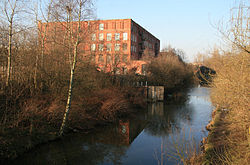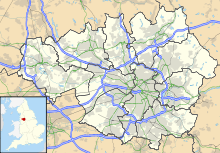- Malta Mill, Middleton
-
Coordinates: 53°32′53″N 2°10′09″W / 53.5481°N -2.1692°E
Malta 
Cotton Spinning (mule twist mill) Location Middleton, Rochdale Serving canal Rochdale Canal Serving Railway Lancashire and Yorkshire Railway Further ownership Lancashire Cotton Corporation (1930s) Coordinates 53°32′53″N 2°10′09″W / 53.5481°N -2.1692°E Construction Completed 1904 Power Date 1904 Construction Firm Buckley & Taylor Decommissioned 1963 Engine Type vertical triple expansion engine Valve Gear Corliss valves on all cylinders rpm 72rpm Diameter of Flywheel 22ft Type of transmission rope No, of Ropes. 32 Boiler configuration Boilers Twin Lancashire, coal fired Pressure 160psi Equipment Mule Frames twist References [1] Malta Mill, Middleton is a cotton spinning mill in Middleton, Rochdale, Greater Manchester, alongside the Rochdale Canal. It was built in 1904 as a new mule mill, by F. W. Dixon. The engine stopped in 1963. The building still stands.
Contents
Location
Middleton is a town within the Metropolitan Borough of Rochdale, in Greater Manchester, England.[2] It stands on the River Irk, 4.7 miles (7.6 km) south-southeast of Rochdale, and 5.1 miles (8.2 km) north-northeast of the city of Manchester. At the time of the United Kingdom Census 2001, Middleton had a population of 45,580. Middleton, is separated from Chadderton by the Rochdale Canal. Middleton Junction stands on the canal. The M60 motorway passes to the south of Middleton; the M62 passes to the north. A heavy rail line enters Middleton from Moston and Blackley to the south, and passes to the east of Middleton's town centre before continuing on northwards to Rochdale. Until 1964 Middleton railway station served the town. Varyingly agreed divisions and suburbs of Middleton include Alkrington, Bowlee, Boarshaw, Cheapside, Greenhill, Hebers, Hollin, Hopwood, Jumbo, Langley, Middleton Junction, Moorclose, Rhodes, Stanycliffe, Stakehill, Thornham and Tonge. Areas such as Greengate and Mills Hill, although in other territories, are often described as part of Middleton.
History
Historically a part of Lancashire, Middleton took its name from being situated in the centre of several circumjacent settlements. In 1770, Middleton was a village of 20 houses; during the 18th and 19th centuries it grew into a thiving and populous seat of textile manufacture, so much so that Middleton was granted borough status in 1886.
During the Middle Ages, Middleton was a centre of domestic flannel and woollen cloth production. Industrial scale textile manufacture was introduced to Middleton as a result of the Industrial Revolution. Middleton became a centre for silk production in the 18th century, which developed into a cotton spinning industry by the mid 19th-century and which continued through to the mid-20th century.[3] Rochdale rose to prominence during the 19th century as a major mill town and centre for textile manufacture during the Industrial Revolution. It was a boomtown of the Industrial Revolution, and amongst the first ever industrialised towns.[4] The Rochdale Canal—one of the major navigable broad canals of the United Kingdom—was a highway of commerce during this time used for the haulage of cotton, wool, coal to and from the area.[4] In 1882, Rochdale the home of industrial co-operatives, embraced the joint stock limited company and new mills were financed and built.[5] Its ownership model was slightly different from that of Oldham, and more shares remained in the hands of the operatives. The Rochdale Limiteds were some of the first to adopt ring spinning.
Malta Mill was one of a cluster of mills built in 1904–05.
The industry peaked in 1912 when it produced 8 billion yards of cloth. The Great War of 1914–18 halted the supply of raw cotton, and the British government encouraged its colonies to build mills to spin and weave cotton. The war over, Lancashire never regained its markets. The independent mills were struggling. The Bank of England set up the Lancashire Cotton Corporation in 1929 to attempt to rationalise and save the industry.[6] Malta Mill, Middleton was one of 104 mills bought by the LCC, and one of the 53 mills that survived through to 1950.
Malta Mill still stands in 2010 and is used by many businesses; including for document storage and as a bonded warehouse.
Architecture
Designed by F. W. Dixon and built in 1905. A substantial building from Accrington brick.
Power
Driven by a 1200 hp vertical triple expansion engine by Buckley & Taylor, 1904. It had a 22 ft flywheel, 32 ropes operating at 72rpm. Its cylinders, 20"HP, 32"IP, 52"LP, had a 4 ft stroke. It was steamed at 160psi. 72rpm. 22 ft flywheel, 32 ropes. Corliss valves on all cylinders. The air pump was driven from LP crosshead. It had an eight bearing crankshaft. [7]
Equipment
110,160 mule spindles in 1915.
Later extensions
Usage
Owners
- Lancashire Cotton Corporation (1930s–1964)
- Courtaulds (1964–
Tenants
Notable events/media
See also
Lancashire cotton Architects 
Engine makers Daniel Adamson · Ashton Frost · Ashworth & Parker · Bateman & Sherratt · Boulton & Watt · Browett & Lindley · Buckley & Taylor · Carel · Earnshaw & Holt · Goodfellow · Fairbairn · W & J Galloway & Sons · B Goodfellow · Hick, Hargreaves & Co · Benjamin Hick and Sons · John Musgrave & Sons · J & W McNaught · Petrie of Rochdale · George Saxon · Scott & Hodgson · Urmson & Thompson · Yates of Blackburn · Yates & Thom · Whilans · J & E Wood · Woolstenhulmes & RyeMachinery makers Brooks & Doxey · Butterworth & Dickinson · Curtis, Parr & Walton · Dobson & Barlow · John Hetherington & Sons · Joseph Hibbert · Howard & Bullough · Geo. Hattersley · Asa Lees · Mather & Platt · Parr, Curtis & Madely · Platt Brothers · Taylor, Lang & Co · Textile Machinery Makers Ltd · Tweedales & Smalley- Oldham Limiteds · Fine Spinners and Doublers · Lancashire Cotton Corporation · Courtaulds · Bagley & WrightIndustrial processes Textile manufacturing · Cotton-spinning machinery · Friction Spinning · Magnetic ring spinning · Open end spinning · Ring spinning · Spinning frame · Spinning jenny · Spinning mule · Water frame · Roberts Loom · Lancashire LoomLists of mills LCC mills · Bolton · Bury · Cheshire · Derbyshire · Lancashire · Manchester · Oldham · Rochdale · Salford · Stockport · Tameside · WiganMuseums Bury Pilot Mill, Bury · Wilton Mill, Radcliffe
Bolton Lancashire Manchester and Salford Oldham Ace Mill, Hollinwood · Blackridings Mill, Oldham · Dawn Mill, Shaw · Fox Mill, Hollinwood · Hawk Mill, Shaw · Heron Mill, Hollinwood · Junction Mill, Middleton Junction · Kent Mill, Chadderton · Laurel Mill, Middleton Junction · Magnet Mill, Chadderton · Majestic Mill, Waterhead · Manor Mill, Chadderton · Newby Mill, Shaw · Orme Mill, Waterhead · Regent Mill, Failsworth · Royd Mill, Oldham · Royton Ring Mill, Royton · Rutland Mill, Shaw · Textile Mill, Chadderton · Trent Mill, ShawRochdale Stockport Elder Mill, Romiley · Kingston Mill, Stockport · Palmer Mills, Stockport · Vernon Mill, Stockport · Welkin Mill, Lower BredburyTameside Atlas Mill, Ashton-under-Lyne · Cedar Mill, Ashton-under-Lyne · Rock Mill, Ashton-under-Lyne · Saxon Mill, Droylsden · Stalybridge Mill, Stalybridge · Texas Mill, Ashton-under-Lyne · Tudor Mill, Ashton-under-Lyne · Waterside Mill, Ashton-under-LyneWigan West Yorkshire Foxsons Mill, Staincliffe · Mons Mill, TodmordenReferences
- ^ LCC 1951
- ^ "Greater Manchester Gazetteer". Greater Manchester County Record Office. Places names – M to N. http://www.gmcro.co.uk/Guides/Gazeteer/gazzm2n.htm. Retrieved 8 October 2007.
- ^ Rochdale Metropolitan Borough Council (N.D.), p. 29.
- ^ a b McNeil, R.; Nevell, M. (2000), A Guide to the Industrial Archaeology of Greater Manchester, Association for Industrial Archaeology, ISBN 0-9528930-3-7
- ^ Williams & Farnie 1992, p. 44
- ^ Dunkerley 2009
- ^ Roberts 1921
Notes
Bibliography
- Dunkerley, Philip (2009). "Dunkerley-Tuson Family Website, The Regent Cotton Mill, Failsworth". http://dunkerley-tuson.co.uk/regentmill.aspx. Retrieved 2009-01-09.
- LCC (1951). The mills and organisation of the Lancashire Cotton Corporation Limited. Blackfriars House, Manchester: Lancashire Cotton Corporation Limited.
- Roberts, A S (1921), "Arthur Robert's Engine List", Arthur Roberts Black Book. (One guy from Barlick-Book Transcription), http://oneguyfrombarlick.co.uk/forum_topic.asp?TOPIC_ID=7926&FORUM_ID=99&CAT_ID=3&Forum_Title=Rare+Text+(Book+Transcriptions)&Topic_Title=ARTHUR+ROBERTS+ENGINE+LIST&whichpage=1&tmp=1#pid81483, retrieved 2009-01-11
External links
Categories:- Textile mills owned by the Lancashire Cotton Corporation
- Textile mills in Rochdale
- Middleton, Greater Manchester
Wikimedia Foundation. 2010.

